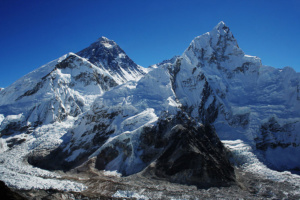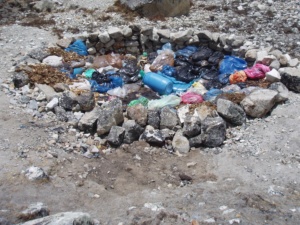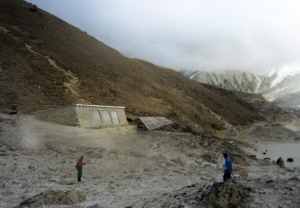For close to two months each spring, a civilisation comes to life at Everest Base Camp. Sanitation in these higher reaches is a major issue, with close to 12,000kg of human waste piling up by the end of the climbing season. A team from the Mt. Everest Biogas Project looks to address the issue.

Climate is no longer the only major challenge for Everest climbers. It’s poop!
Human waste left behind by climbers is a major challenge on Mount Everest. A project is now trying to break the nasty stuff down to generate biogas.
At one end of Kathmandu University is an isolated structure that is not too popular with the students. A few signs on the door announce “Human faecal matter”, “Highly contagious” and “Do not enter”. Those working inside, led by Bed Mani Dahal, associate professor of the Department of Environmental Science & Engineering, could hardly disagree with the revulsion caused by the project his team is associated with.
“You don’t really feel comfortable when you are working with human faeces — the smell is the worst part of it. Precautions are a must because you can also get easily infected,” Dahal says, smiling.
It’s just another day in the life of the researchers, from Kathmandu University and Seattle University, who are associated with the Mt Everest Biogas Project that looks to address the poop issue on the highest mountain in the world. According to the records of the NGO, Sagarmatha Pollution Control Committee, around 12,000 kg of human waste is generated each year on Everest, 80% of which is produced in the spring climbing season alone (April-June). This waste is carried off the mountain and down to the village of Gorak Shep in Nepal — the first human settlement for those descending the mountain, after the Everest base camp — where it is simply dumped in unlined pits in the area, leading to serious issues of contamination.
“When water seeps through the ground, it looks clean because it’s filtered through the soil. But it has a lot of pathogens due to this human waste, which makes it unsafe for the local community,” says Michael Marsolek, associate professor at Seattle University.
The idea to find a solution was first conceived around a decade ago. Dan Mazur, an American mountain guide who leads expeditions up Everest, was all too aware of the impending problem, ever since commercial expeditions took off in the early ’90s. According to The Himalayan Database, while there were 77 successful ascents between 1985 and 1989, that figure escalated to 634 in 2015-17. Add to that the expedition support staff, and Everest sees a civilisation at base camp during the climbing season each year. Mazur got together with Garry Porter from Engineers Without Borders to conceptualise a biodigester that could convert the human waste into methane gas, which could be used by the local community for cooking.

This would also reduce their dependency on other fuels. With a little treatment, the residue left behind could also be used as fertilisers.
“Cutting of wood for fuel led to defoliation wherever there was vegetation. Besides, homes burning wood or yak dung led to inhabitants getting pulmonary diseases,” Porter says. “The design of the bio-digester was deliberately made open source, so that it can be replicated and it has drawn interest from organisations in Pakistan and Iran as well.” The concept isn’t novel in terms of implementation. In the lower reaches of Nepal, around 3,00,000 bio-digesters process faecal waste, animal dung and crop residue to cater to the needs of rural households. In fact, the Nepal government even provides subsidies for the installation through the biogas support programme. But at higher elevation, the altitude and the erratic weather patterns add to the challenge. “Bacteria can easily break down mixed waste, as compared to solely faecal matter. And at those heights, the process takes longer,” Marsolek explains.

Over the last four years, the team has worked on a bio-digester design that exclusively processes human waste. The facility at Kathmandu University was then used to simulate conditions on the mountain to understand the optimum temperature at which microorganisms could break down the waste and produce adequate biogas. On the mountain, solar panels would help a bio-digester maintain suitable temperatures. “Researchers have been able to generate biogas at high temperatures, but they’ve not had much success in low-temperature areas. This is the main constraint, so we spent a lot of time on the design of an insulated greenhouse and regulating temperature inside it. We’ve had success in the lab and now look to scale up,” Dahal says.
A major aspect of their work has been fundraising — for the research, as well as to construct the facility at Gorak Shep. So far, a crowdfunding campaign has managed to raise around $2,600 in nine months. The project was also awarded the UIAA Mountain Project Award last year, which earned them a grant of $5,000. “It’s hard to arrive at a figure until we start building. But if a bag of cement costs Rs 1,500 in Kathmandu, it’s about Rs 20,000 up in the mountain. A porter must carry it for two weeks to get it there, else it has to be ferried by helicopter, which is $2,400 an hour. At least two-thirds of the total cost is transportation,” Mazur says.
Once in operation, the project will provide fuel for the local community and will address the environmental hazard on Everest. It will also generate employment as people would have to be hired to maintain the bio-digester and the pipelines distributing the gas. “One problem with these humanitarian engineering projects is that they are not monitored for a long time, so our fundraising accounts for this as well,” Marsolek says.
If the funds are gathered, the project could be implemented as soon as monsoon next year. “The great thing about Mt Everest is that there’s a lot of appeal — there’s only one Everest, after all. And we hope that will encourage others to join in,” Mazur says.